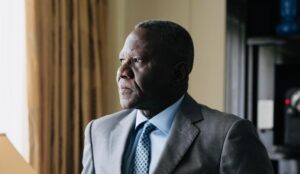
In the heart of Nairobi’s business district, a young entrepreneur named Ayanda gazed out of her office window, contemplating the journey she had undertaken. It had been a whirlwind of a year for her tech startup, DigiLink, which was designed to provide affordable digital services for small businesses across Africa. At just 34, Ayanda had carved out a promising career, but as any leader knows, success comes with its share of setbacks.
Her latest hurdle was a monumental one: a major contract had just fallen through. The government tender that she had worked so hard for, one that would have catapulted her company into the big leagues, had been awarded to a competitor. The blow stung. It wasn’t just about the loss of the contract; it was about the resources and energy she had invested, the faith her team had placed in her, and the looming financial consequences.
Ayanda was no stranger to challenges, but this was different. The pressure mounted as her investors became anxious, and her employees began whispering about uncertainty. The overwhelming feeling of failure threatened to derail her, but deep down, she knew that true leadership was tested in moments like this. She needed to bounce back, not just for herself, but for her team, her vision, and for the continent that inspired her work.
Facing the Setback
The first step was acceptance. Ayanda understood that the sooner she confronted the reality of the setback, the faster she could formulate a plan to move forward. She gathered her leadership team in the conference room—a mix of young minds from across Africa. There was Kofi from Ghana, the quiet but brilliant CTO, always solving technical problems with ease. Nandi from South Africa, their sharp and determined marketing head, had a knack for selling even the most abstract of concepts. And then there was Ahmed from Egypt, the CFO, whose number-crunching and risk-assessment had saved them from a financial misstep just months before.
As they sat in silence, Ayanda felt the weight of their expectations. She took a deep breath. “We lost the contract,” she began. “But this isn’t the end of the road. We’ve built something incredible here, and one setback won’t define us.”
Nandi was the first to speak up. “We need to find another big client, fast. Otherwise, we’re going to have to make some tough decisions,” she said, her voice laced with urgency.
Kofi, typically reserved, leaned forward. “Or we can pivot. Maybe our technology can serve a different sector?”
Ahmed nodded in agreement but added, “The financial runway is short. We need to make strategic moves—fast.”
The Pivot
Ayanda knew they were right. Dwelling on the lost opportunity would only paralyze them. Instead, she took Kofi’s idea seriously. “Let’s explore pivoting our services,” she suggested. “But we need data. Who else can benefit from what we’re offering?”
Over the next few days, the team threw themselves into research. Ayanda worked tirelessly, even traveling to neighboring Uganda and Tanzania to meet potential clients. She soon discovered that a growing sector in agriculture was ripe for digital transformation. Smallholder farmers across East Africa were struggling to access essential markets, resources, and information to boost productivity.
Ayanda saw an opportunity: DigiLink could adapt its platform to serve this sector. They could provide farmers with digital tools to access markets, weather updates, and financial services. It was a risk, but she was confident that the resilience and adaptability of her team could make it work.
Building Resilience
The shift wasn’t easy. Many employees were nervous about the sudden change in direction, and Ayanda knew that to maintain morale, she had to inspire confidence. “Leadership isn’t just about guiding through success,” she reminded her team during a company-wide meeting. “It’s about how we rise when things don’t go as planned.”
One of her key strategies was transparency. Instead of shielding her team from the financial difficulties and pressure from investors, she was open about the challenges they faced. She believed that resilient leadership was about empowering her team with information and involving them in the solution.
Her approach paid off. As the weeks went by, the team became more united, rallying around the new vision. They refined their platform, with Kofi leading the technical adjustments to meet the needs of farmers, and Nandi orchestrating a new marketing campaign that focused on rural development. Ahmed worked tirelessly to secure short-term funding to keep the business afloat while they pursued this new venture.
Challenges from Within
However, resilience wasn’t just tested by external factors. Ayanda soon found herself facing internal challenges as well. Some employees struggled to adjust to the new focus, particularly those who had joined the company with a passion for the original vision of serving urban businesses. A few key staff members even resigned, feeling disillusioned by the change in direction.
Ayanda understood their frustration but remained firm in her decision. She held individual meetings with each department, listening to concerns and reassuring those who stayed that their contributions were more important than ever. “This is a setback,” she admitted during one particularly tense meeting with the product development team. “But resilience isn’t about never encountering problems. It’s about how we respond. This new path we’re on—it’s going to make a difference. Not just for our company, but for communities across Africa.”
A New Beginning
Months passed, and the pivot began to show signs of success. Smallholder farmers in Kenya, Uganda, and Tanzania embraced DigiLink’s tools, and the company started gaining traction in the agricultural sector. It wasn’t the path they had originally envisioned, but it was a path that mattered.
Ayanda’s leadership was put to the test throughout the process. The setbacks she had faced forced her to grow, to adapt, and to build a more resilient company. She learned that resilient leadership isn’t just about bouncing back from setbacks but growing stronger through them.
One evening, as the sun set over the Nairobi skyline, Ayanda sat with her team, reflecting on how far they had come. They had weathered a storm and emerged with a renewed sense of purpose. “We may have lost that contract,” she said, “but we found a new direction—one that we never would have considered without the challenges we faced.”
Nandi smiled. “We didn’t just bounce back. We rebuilt stronger.”
Ahmed, always the realist, added, “And with a better balance sheet.”
Ayanda laughed, grateful for the team that had stayed by her side through it all. “Resilience,” she said, “isn’t just about survival. It’s about creating new opportunities from the ashes of failure.”
Conclusion
Ayanda’s journey is a testament to the power of resilient leadership. Through setbacks and uncertainty, she learned that bouncing back isn’t about returning to where you were before—it’s about evolving into something greater. Her leadership was shaped by the challenges she faced, and her company emerged stronger, ready to make a lasting impact on the African continent.
In the end, Ayanda realized that setbacks are not roadblocks but stepping stones to a new future—one where resilience becomes the driving force behind success.








